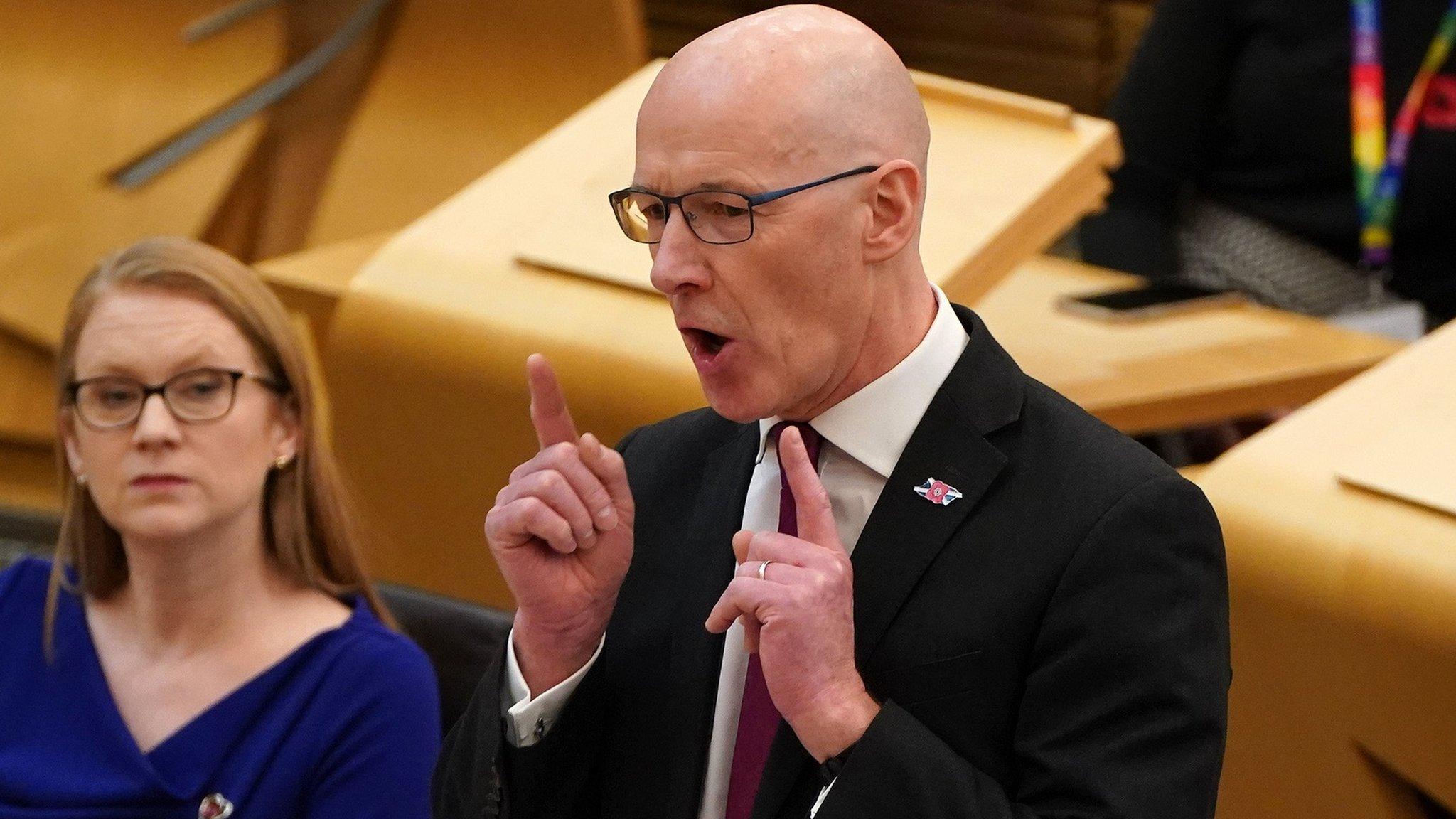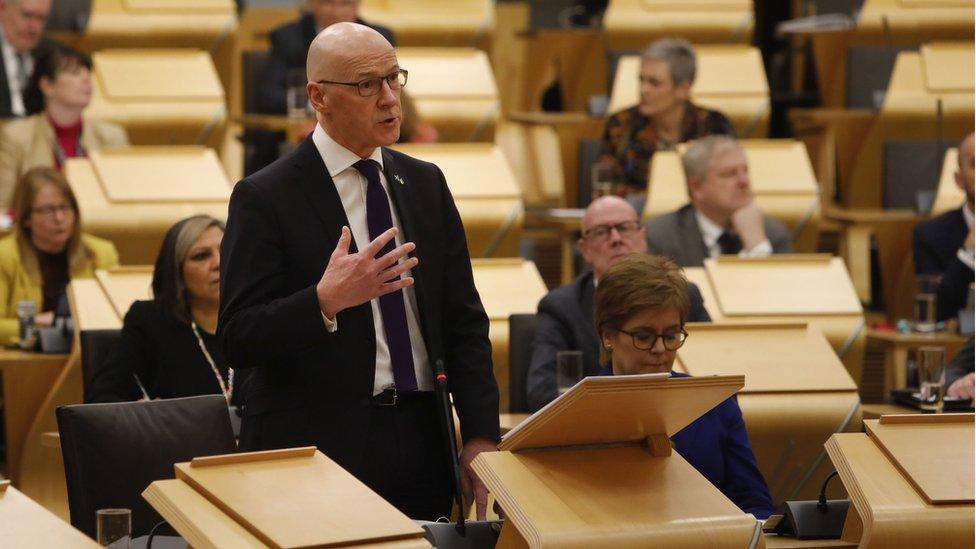Scottish income tax 2023-24 - What might you be paying?
- Published

The Scottish government's Budget statement includes changes to two of the five income tax bands.
Deputy First Minister John Swinney, who is acting finance secretary while MSP Kate Forbes is on maternity leave, told Holyrood that raising the higher rate from 41p to 42p and the top rate from 46p to 47p in the pound would raise an additional £129m in 2023-24. Also, the threshold at which people start paying the top rate is to drop from its current level of £150,000 to £125,140.
Based on these changes, tax consultant Deloitte has put together examples spanning different salaries.
The lower earner
£15,000 salary
If you earn a salary of £15,000 in 2023-24 and have no other income, the personal allowance of £12,570 will be deducted and £2,430 will be taxable.
If you are resident in Scotland, your income tax calculation will be as follows;
Scottish starter rate - £2,162 at 19%= £410.78
Scottish basic rate - £268 at 20% = £53.60
Total tax = £464.38
There is no change compared to 2022/23 as the personal allowance, lower rate bands and lower tax rates are frozen.
If you earned the same sum of money but were not resident in Scotland the full £2,430 would be taxable at 20% (UK basic rate) producing an income tax bill of £486. Therefore, you would pay £21.62 less as a resident of Scotland.
The medium to higher earners
£33,000 salary
If you earn a salary of £33,000 in 2023-24 and have no other income, the personal allowance of £12,570 will be deducted and £20,430 will be taxable. If you are resident in Scotland, your income tax will be as follows:
Scottish starter rate - £2,162 at 19% = £410.78
Scottish basic rate - £10,956 at 20% = £2,191.20
Scottish intermediate rate - £7,312 at 21% = £1,535.52
Tax total = £4,137.50
There is no change compared to 2022/23 as the personal allowance, lower rate bands and lower tax rates are frozen.
If you were resident elsewhere in the UK, the full £20,430 would be taxable at 20%, giving an income tax liability of £4,086. A Scottish resident would pay an additional £51.50 in income tax compared with living elsewhere in the UK.
£50,000 salary
If you earn a salary of £50,000 in 2023-24 and have no other income, £37,430 will be taxable after deduction of the £12,570 personal allowance.
If you are resident in Scotland, the tax calculation will be as follows;
Scottish starter rate - £2,162 at 19% = £410.78
Scottish basic rate - £10,956 at 20% = £2,191.20
Scottish intermediate rate - £17,974 at 21% =£3,774.54
Scottish higher rate - £6,338 at 42%= £2,661.96
Total tax = £9,038.48
This is an increase of £63.38 compared to 2022/23 due to the increase in the Scottish higher rate of tax.
If you were not resident in Scotland, the full £37,430 will be taxable at 20% (UK basic rate) producing an income tax bill of £7,486. You would therefore be paying £1,552.48 more in tax as a resident of Scotland.
The higher earner
£200,000 salary
If you earn a salary of £200,000 in 2023-24 and have no other income, you are not entitled to a personal allowance because your income exceeds £125,140. The taxable income is therefore £200,000.
If you are a resident in Scotland, your income tax breaks down is as follows:
Scottish starter rate - £2,162 at 19% = £410.78
Scottish basic rate - £10,956 at 20% = £2,191.20
Scottish intermediate rate - £17,974 at 21% =£3,774.54
Scottish higher rate - £94,048 at 42% = £39,500.16
Scottish top rate - £74,860 at 47% = £35,184.20
Total tax = £81,060.88
This is an increase of £2,932.08 compared to 2022/23 due to the reduction in the top rate threshold from £150,000 to £125,140 and the increases in the Scottish higher rate and top rate of tax.
If you are a resident elsewhere in the UK, on this salary you would pay £76,203 in tax - £4,857.88 less than north of the border.
Analysis - Following Chancellor on top rate threshold drop 'unsurprising'
Garry Tetley, Tax Partner at Deloitte, said: "The Scottish higher rate threshold remains at £43,662 for a third year running, which is still significantly lower than the UK higher rate threshold of £50,270 which has been frozen until 2027/28.
"Unsurprisingly, the Scottish government has followed Westminster's lead in reducing the top rate income tax threshold from £150,000 to £125,140, the point at which the personal allowance ceases to be available. The effective rate of income tax between £100,000 and £125,140 is increasing from 61.5% to 63% due to the combination of the tapering of the personal allowance and the increase in the Scottish higher rate.
"Based on the changes announced today, no Scottish taxpayers will see a reduction in their income tax bills. Those earning more than £43,662 will pay more income tax. The biggest increases will be for those earning more than £125,140.
"Lower earners in Scotland continue to pay less tax than those in the rest of the UK; the breakeven point for both 2022/23 and 2023/24 is £27,850.
"The Scottish government's devolved powers for personal taxes are limited to setting the bands and rates of income tax for non-savings non-dividend income, such as salaries, profits and pensions.
"Income tax on savings and dividend income, capital gains tax and national insurance are all set by the Westminster government. As announced in the Autumn Statement, the nil-rate band for dividends will be halved from £2,000 to £1,000 from 6 April 2023, and halved again to £500 from 6 April 2024.
"The capital gains annual exemption will be cut from £12,300 to £6,000 from 6 April 2023 and cut again to £3,000 from 6 April 2024. National insurance will be slightly lower in 2023/24 as a whole compared to 2022/23 due to the mid-year reversal of the rate rise following the "mini-budget". For most employees there will be no change in their monthly or weekly national insurance liabilities as we move into the new tax year."
- Published14 December 2022

- Published15 December 2022
